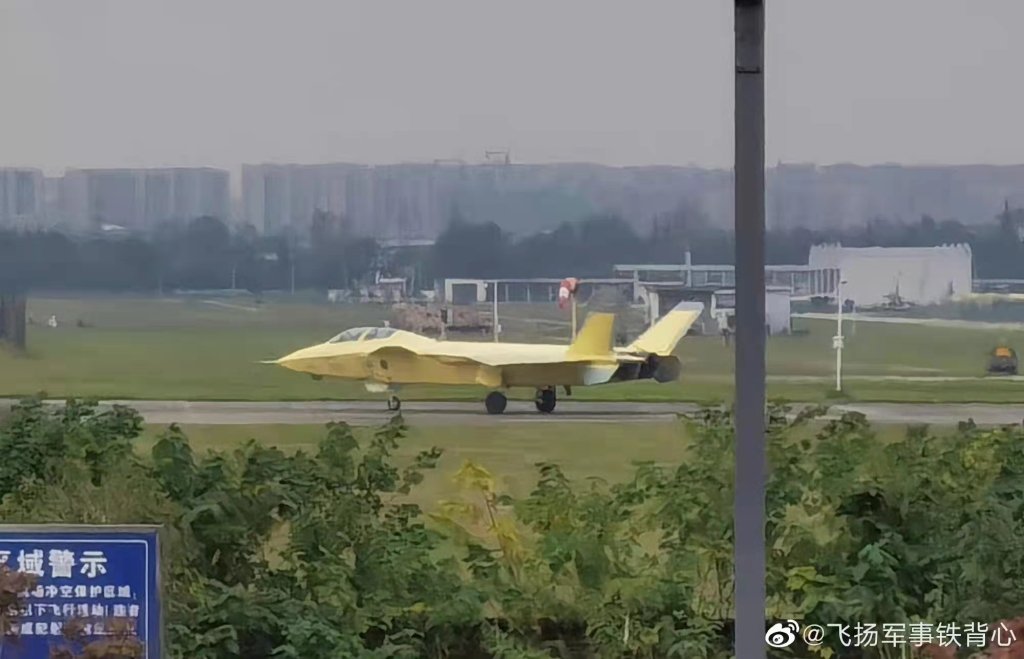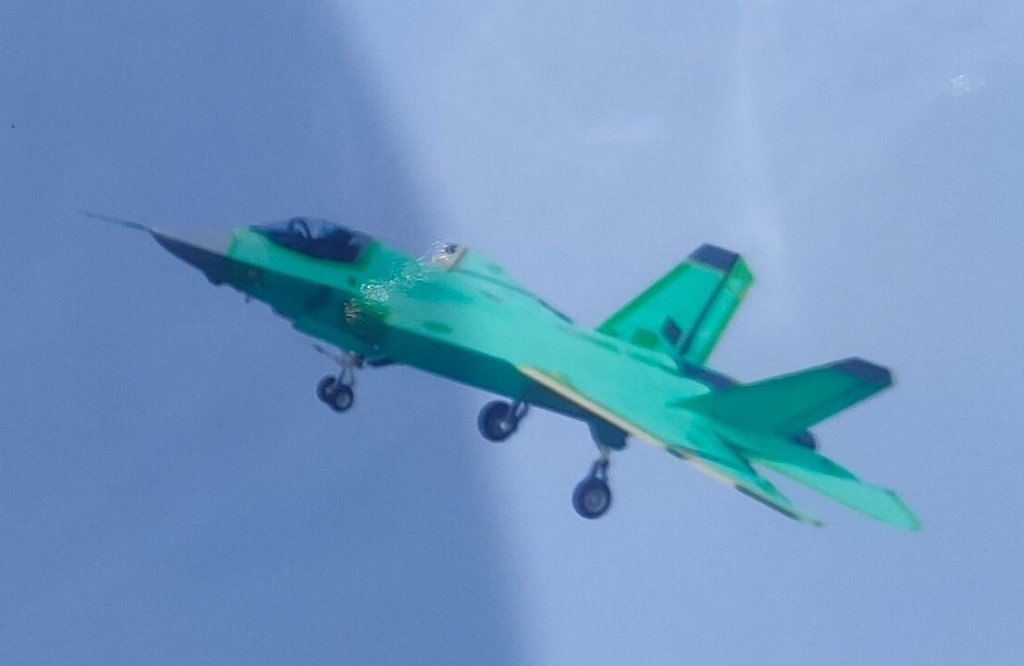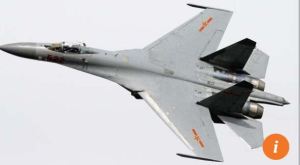China ‘Unveils’ Series Of Stealth Fighter Jets; Has Beijing Finally Outclassed Its ‘Mentor’ In Aircraft Technology?
Posted: November 4, 2021 Filed under: Uncategorized | Tags: 2-seater J-20, AESA, aircraft engine, BVR missile, China, FC-31, fighter jet, J-11B, J-11D, J-16, J-20, PL-12, PL-15, Russia, Su-35, Su-57, WS-10C, WS-15 3 CommentsBy EurAsian Times Desk- November 3, 2021
China has long been depending on the Russian aviation industry for its fighter jet requirements. However, Beijing’s reliance on Russia could soon be over if the latest photographs of the twin-seat variant of China’s J-20 stealth jets are anything to go by.
As if that were not enough, additional photographs have surfaced on social media showing China’s first carrier-based fighter plane. With these new developments, China appears to have already overtaken its “mentor” Russia.
According to a study published by the Royal United Service Institute (RUSI), a military think tank, China may have already surpassed the Russian warplanes.
The former’s increasing dominance in fighter jets technology is based on different factors such as large military budget, willingness to reverse-engineer existing technology, and cross-applicability of China’s well-developed civilian electronics industry to the manufacturing of advanced avionics.

On the contrary, sanctions imposed by the West on Russia have constrained Moscow’s access to components required for high-performance sensors. Chinese aircraft are outpacing their Russian counterparts in terms of design as well.
Are Chinese Jets Better?
Any aircraft’s agility and speed can be improved by reducing its weight. Substituting lightweight composite materials for metal components is one of the most important weight-saving techniques in current aircraft design.
The usage of composites on a large scale can be costly and technologically challenging. Despite this, China is using composites in the J-11B, J-11D, and J-16 fighters, all of which are based on Russian Flankers. As a result, compared to the original Russian jets, the Chinese jets have a better thrust-to-weight ratio.
For its Y-20 “Chubby Girl” transport planes, the Xi’an Aircraft Corporation revolutionized composite technology by 3D-printing composite components and adopting innovative computer-assisted design techniques.
The Active Electronically Scanned Array (AESA) radar is the current gold standard in sensor technology, with more range, higher resolution, and the capacity to sustain numerous tracks than its predecessors. AESA radars are much more difficult to detect, allowing for target searching without revealing one’s position.
China’s J-11B/D, J-15, and J-16 twin-engine fighters, J-10 single-engine fighters, and J-20 stealth aircraft are all equipped with AESAs. Meanwhile, Russia is lacking behind in terms of the operationality of AESA in its Su-57 stealth fighter and MiG-35.
The wide incorporation of AESA radars into recent Chinese designs guarantees that they’ll have better sensor abilities comparable to cutting-edge Western fighters.
Beyond-visual-range (BVR) warfare relies on missiles that can engage opponents at larger distances in addition to sensors and in the past few years, China has begun to deploy two advanced BVR missiles. The first is the PL-12, which has performance comparable to the US AIM-120C missile and outranges the Russian R-77 BVR missile.
FC-31

China has also produced the PL-15 missile, which is said to meet or exceed the range of even the most recent US AIM-120D BVR missiles. Meanwhile, Russia has had difficulty deploying adequate numbers of the R-77-1 missile.
RUSI reports suggest that Russia’s short-range R-73 heat-seeking missiles have a superior overall reputation, they lack an infrared imaging sensor that can differentiate aircraft from flare decoys, unlike its Chinese and US counterparts.
Engine technology is one area where China still needs to surpass Russia, Beijing continues to purchase Russian turbofan engines as it tries to develop local alternatives such as the WS-10B and, eventually, the powerful WS-15.
However, as EurAsian Times reported, China’s J-20 ‘Mighty Dragon’, was spotted with a domestically manufactured WS-10C engine at the Zhuhai airshow.
Jet engine technology was one area where China was lagging behind, but now that is almost taken care-off, as Beijing could eventually replace the Russian-made AL-31F turbofans with fully indigenous engines that only a few nations have been able to master.
Source: EurAsian Times “China ‘Unveils’ Series Of Stealth Fighter Jets; Has Beijing Finally Outclassed Its ‘Mentor’ In Aircraft Technology?”
Note: This is EurAsian Times’ article I post here for readers’ information. It does not mean whether I agree or disagree with the article’s views.
China’s New J-11 Variant Better than Su-35
Posted: April 22, 2019 Filed under: Uncategorized | Tags: AESA radar, China, Distributed Aperture System, F-35, J-11D, J-20, PL-15, PL-21, R-27, R-77, Su 35, vector engine, WS-10A, YJ-12 6 CommentsThe Diplomat says in its article “Why is China Developing a New J-11 Variant?” that China has developed a new variant of J-11 the J-11D “4++ generation” air superiority fighter superior to Russia’s Su-35 that China has imported.
According to the article, Su-35 was developed in 2000s with technologies developed in the 1990s while the J-11D as a later development with newer technology is considerably more sophisticated so that it will very likely surpass Su-35 in its combat performance.
J-11D integrates some of the most capable Russian military aviation technologies. It uses more composite materials for a stronger but lighter airframe. Its electronic warfare systems and sensors are the latest development comparable with J-20’s and more advanced than Su-35.
It has better situation awareness than Su-35 as it uses a miniaturized active electronically scanned array (AESA) radar better to detect at range than Su-35’s passive electronically scanned array radar. Moreover, the article says, “The J-11D could potentially integrate a Distributed Aperture System, a cutting edge technology currently deployed only by the J-20 and American F-35.”
In addition, some stealth technologies are adopted in J-11D, such as radar absorbent coatings to reduce its radar cross section.
J-11D uses WS-10A three dimensional thrust vectoring engines to make it highly maneuverable.
It carries China’s new PL-15 air-to-air missile with a 150km engagement range longer than the R-77 and extended range variants of the R-27 used by Su-35.
Compared with China’s new 5th-generation stealth fighter jet J-20, it can carry larger missiles with far wider range than those carried in J-20’s internal weapon bay such as the ship hunting YJ-12 and ramjet powered PL-21 “AWACS hunter”.
With comparable electronic warfare systems and sensors, and with some stealth technologies of its own, J-11D is an effective next generation complement to the J-20 for decades to come. Moreover, it is likely to be considerably cheaper to operate and easier to maintain.
As for whether J-11D is the best of its kind, the article says, “How the aircraft will compare to Boeing’s F-15X, an advanced “4++ generation” air superiority platform currently on order for the U.S. Air Force, which is in many ways conceptually similar to the J-11D, remains to be seen.”
Comment by Chan Kai Yee on The Doplomat’s article, full text of which can be viewed at https://thediplomat.com/2019/04/why-is-china-developing-a-new-j-11-variant/.
Russia-China Military Cooperation Add Wings to Two Tigers
Posted: March 10, 2018 Filed under: Uncategorized | Tags: China, F-117S engine, J-11D, J-20, PLAAF, Russia, South China Sea, Su 35, Wang Mingzh 8 CommentsRussian Sputnik website says in its report that Russian military expert Vasily Kashin believes that China buys 24 Su-35s mainly for in-depth tests to study Su-35’s performance.
Russia wanted China to buy 48 Su-35s but China only wanted 2. Through 5 years prolonged hard negotiations, China and Russia finally concluded a purchase contract for 24 Su-35s at US$2 billion without transfer of any technology. That is quite expensive. However, China has made Russia agree to have some Chinese components installed in the Su-35s it provides China with. As a result, Chinese aircraft producer may take part in some parts of the manufacture processes of and learn something from the fighter jets.
By the end of 2017, Russia had delivered 14 Su-35s to China. As Russian air force needs lots of Su-35 but has only got about 30, Russia proves that it is China’s good ally in giving priority to supply of Su-35s for China.
According to Kashin, China buys 24 Su-35s mainly for in-depth tests to study its performance in order to facilitate accurate decisions on the direction of development of its J-11 heavy fighter, J-15 carrier-based fighter and J-16 fighter/bomber.
For such study, 2 are really enough. Paying $2 billion for 24, in which only 2 are needed, shows the abundance of funds Chinese military has so that China does not grudge the expense in satisfying its urgent needs for military modernization. Perhaps, China did that also to help Russia that is hard up due to Western sanctions.
There are also reports that China is interested in the very powerful F-117S vector thrust engines on Su-35 that may be imported along with Su-35. However, Russia is unwilling to sell as many as F-117S engines as China wants when the sales contract was entered into by the two countries.
In September 2017, there was report that Russia suddenly agree to sell China 400 F-117S engines.
China has developed its J-11D as good as Su-35 except its engines. When F-117S is installed on J-11D, China will be able to produce lots of the best three-and-a-half generation fighter jets in the world.
There are also reports that the engine will be used on China’s most advanced J-20 stealth fighter jet. As China’s progress in developing its WS-15 engine for J-20 is confidential, we don’t know whether such reports are true.
Anyway, China will get good engines to strengthen its air force while Russia will obtain funds for its confrontation with the United States and EU. It proves my prediction that military cooperation between China and Russia will add wings to two tigers.
The 24 Su-35s China imported more than China wants, though not stealth, are quite useful due to their advanced functions and performance. Chinese air force announced on February 7, 2017 that China’s Su-35s were deployed in a combat patrol in the South China Sea along with other Chinese warplanes.
In an interview with Xinhua news agency, Wang Mingzhi, a professor with the PLA Air Force Command Academy said that the deployment is expected to improve the air force’s adaptive capacity in complicated situation in the air and on the sea. It enhances China’s ability to maintain national sovereignty and security and maritime interests in the South China Sea area.
According to Wang, the patrol mission is an annual training of combat readiness to maintain China’s sovereignty and security and maritime interests.
Article by Chan Kai Yee.
China’s Great Progress in Making Homegrown Aircraft Engines
Posted: December 12, 2016 Filed under: Uncategorized | Tags: aircraft engine, China, J-11D, Su 35, WS-10 6 CommentsSCMP says in its report “China powers up military jet engine tech to wean itself off Russian imports” today that China has made huge investment in developing homegrown aircraft engines so that it was able to make 400 WS-10 turbofans last year for its J-10 and J-11 fighters and no longer needed Russian engines for them.
As Russia is unwilling to sell China its advanced 117S engines used in its well-known Su-35 fighter jets, China will use homegrown engines in its newly developed J-11D fighter jet that SCMP regards as China’s homegrown version of the Su-35
SCMP quotes Andrei Chang, founder of the Canada-based Kanwa Defence Review, as saying that China has newly established Aeroengine Corporation of China to concentrate resources for engine development. The corporation has 24 units and about 10,000 employees. According to Chang, China regards engine production as priority, has put quite a lot of resources into engine development over the past two or three years to boost engine industry.
SCMP says “China could also be working on a more advanced engine (than WS-10).” But “A staff member from Aeroengine would not comment on its plans for the engines that would power the J-15 and the J-20 stealth jets.”
Full text of SCMP’s report can be found at http://www.scmp.com/news/china/article/2053741/china-powers-military-jet-engine-tech-wean-itself-russian-imports
China Upgrades J-11B into J-11D Close to Russia’s Su-35 Fighter Jet
Posted: May 4, 2015 Filed under: Uncategorized | Tags: China, F-15C, F/A-18E/F, J-11D, PLAAF, Su 35, WS-10A 7 CommentsMil.huanqiu.com says according to US National Interest bimonthly, on April 29, China conducted maiden flight of its J-11D fighter jet, an upgraded version J-11B.
J-11D incorporated the technologies of China’s J-16, which was delivered to Chinese air force (PLAAF) in April 2014. It uses J-16’s Active Electronically Scanned Array (AESA) radar, which has a larger range to enable it to intercept enemy fighter jet further away.
Moreover, the AESA radar can be datalinked to drones and other Chinese platforms for better awareness of the situation.
Some analysts believe that J-11D is probably Chinese version of Russia’s Su-35. If so, American third-generation fighters such as F-15C and F/A-18E/F are no match to it.
According to a report of Russia Today, J-11D uses more synthetic materials to enable it to carry more air-to-air missiles such as PL-10 and PL-15. According to informed sources, J-11D is powered by two China-made WS-10A engines. If such engines enable J-11D to have performance similar to Russia’s Su-35, China must have made great progress in developing its homegrown aircraft engines.
Source: mil.huanqiu.com “Foreign media: J-11D can be regarded as Chinese version of Su-35 equipped with new phased array radar” (summary by Chan Kai Yee based on the report in Chinese)

